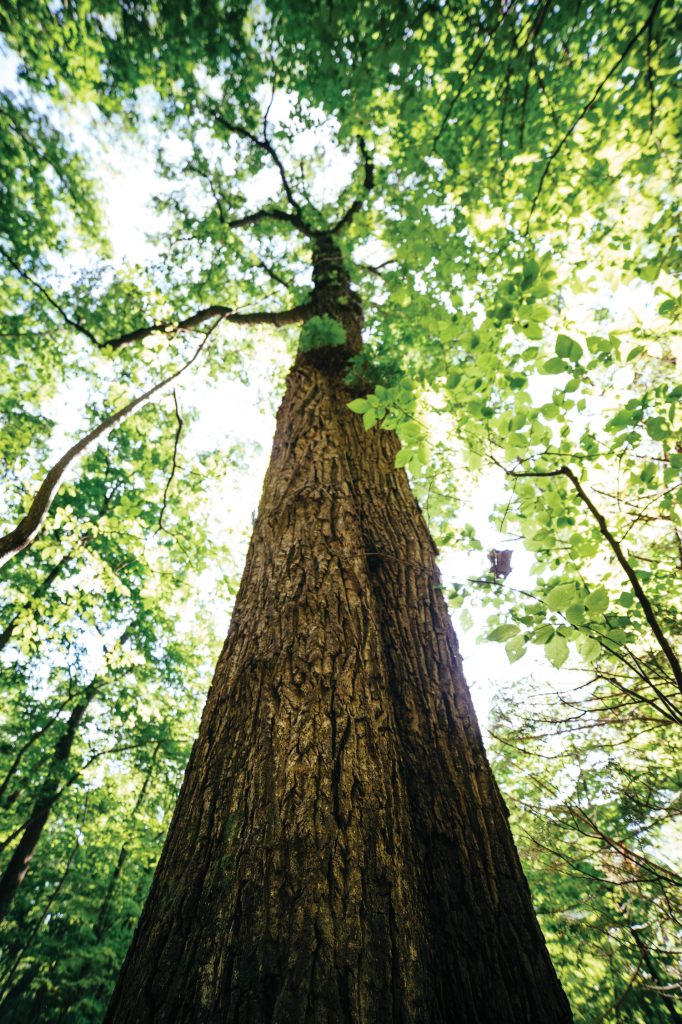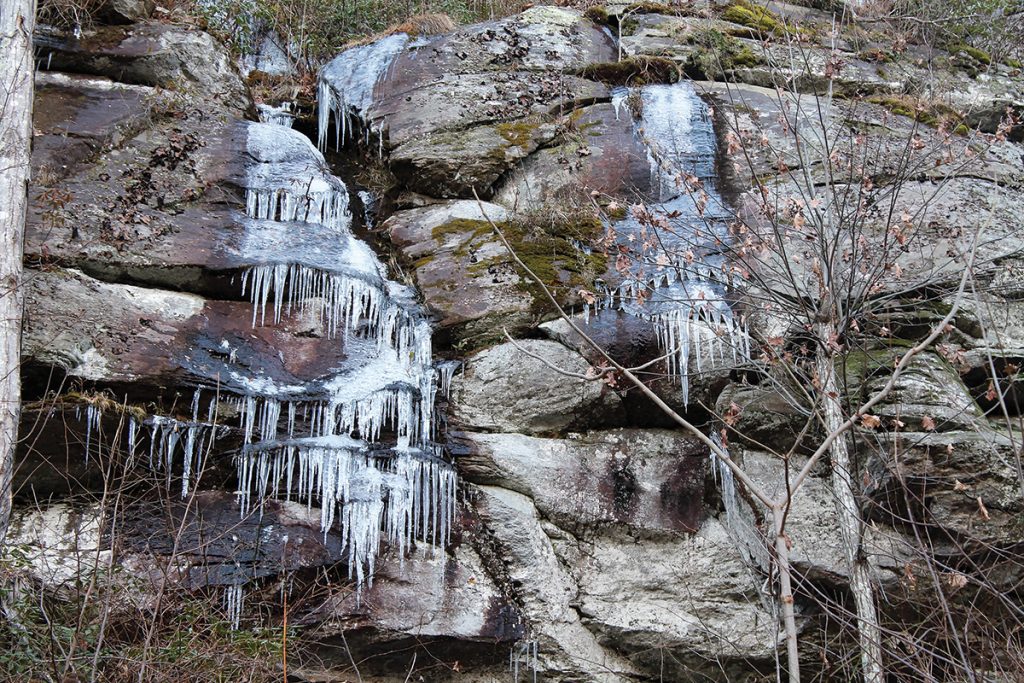
the tallest example of old-growth timber in Chimney Rock Park.
Photo by Rachel Pressley
Located in Hickory Nut Gorge, the nearly 7,000-acre Chimney Rock State Park officially got its name in 2007, after it was purchased by the state of North Carolina. Prior to this, it was owned by the Morse family, who began operating the privately owned park in 1902. During the early 1900s, much of Western North Carolina was being logged, but some trees couldn’t be felled simply due to their placement and elevation along the steep slopes.
Today, Chimney Rock State Park is home to thousands of acres of protected forest, including a pocket of old-growth forest that survived the extensive logging. “Luckily for us, we’ve known the history of the property for a long time and have a good idea of when the areas were timbered,” says Senior Naturalist Emily Walker. “For example, we know that some of the trees are at least 150 years old, which is the age that trees must reach to be considered old growth.”

Photo by Rachel Pressley
Certain patterns provide telltale details. Old-growth trees normally have large canopies that provide a lot of shade, prohibiting other arboreal species to thrive on the forest floor. The forest itself appears more open than other areas, as the trees grow further apart in competition for sunlight. Decaying matter from fallen trees, broken limbs, and other parts of the ecosystem that break down over time are all indicators of old growth. Often, in an old-growth forest, snags, or broken trees, are prominent. Stages in the life cycle of a tree — seed, seedling, sapling, mature tree, snag, log — can provide environmentalists with hints on their age, developmental process, and their history.
Being one of just a few old-growth sites in Southern Appalachia — Joyce Kilmer Memorial Forest in Graham County is the best-known example — the Chimney Rock Park stand is a rare mountain oak/hickory type dominated by hardwoods. In the upper canopy, there are five primary species, all of them native to North America: poplar, northern red oak, chestnut oak, white oak, and a variety of hickory trees. The understory consists of silver bells, sourwoods, and mountain-laurel and rhododendron thickets (or “laurel hells” in the regional vernacular).

Photo by Rachel Pressley
“Because most examples of this forest type are so accessible to logging, it’s difficult to find a stand of it among lower mountain elevations that has not been cut before it exceeds 100 years of age,” explains naturalist Ron Lance, the park’s nursery curator since 2001.
The largest tree in the park is a Chestnut Oak standing more than 120 feet tall. “A notable characteristic of this tree is how gnarly the crown is from over 200 years of competing for sunlight,” says Walker. “The upper branches are very crooked because it’s been trying to reach the top of the canopy around the other trees.” Thanks to similar-looking leaves, the tree gets its name from the American Chestnut, a once prolific specimen that all but disappeared from Eastern forests in the 20th century, due to a devastating blight. “The bark of the Chestnut Oak is deeply furrowed, thick, and fire resistant to protect the cambium cell layer [the vascular system] that the tree uses to feed itself,” explains Walker. The other prominent old-growth trees in the forest are the poplars, known for their almost perfectly straight vertical growth and light-colored bark. (Tulip poplars comprise the largest virgin specimens in Joyce Kilmer Forest.)
Canopy gaps have been created by old oaks and hickories falling in the past 15 years, and the uneven ages of trees within the Chimney Rock tract make it unique. When hiking through, one can easily notice the many fallen and rotting logs, hollow tree trunks turned animal dens, and the few younger trees that are growing to someday be as tall as their descendants.
While the acreage around the largest trees in the park is usually off limits to the public and therefore without a trail system, Walker and Lance still want to educate people on the importance of protecting the area via special guided hikes, like the one scheduled this month. The old-growth tract faces many natural threats already, including high winds, so naturalists work to keep the human footprint as small as possible. “High winds are actually one of the biggest natural threats that the old-growth trees face,” says Walker. Trees of this age grow tall enough to tower over the younger trees, making them a direct target. “Wind really is a tree’s nemesis,” she notes.

Since the area is inside an official state park, the forest will remain protected for years to come. “As our population continues to grow, pressures on the environment that we knowingly and unknowingly depend on will also expand,” Lance states. “Our present and forthcoming generations will have to endure environmental problems that need to be managed in ways not repetitious of past indifference.
“Environmental education should be seen as a fortification of how to live and let live.”
“The Naturalist Niche: Big Tree Walk” at Chimney Rock State Park (431 Main St., Chimney Rock) happens Saturday, July 20, 9am-12pm, led by Ron Lance. Space is limited and advance registration is required. $5-$23. For more information, call 828-625-9611 or see chimneyrockpark.com.



